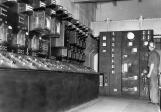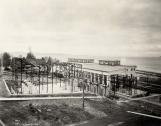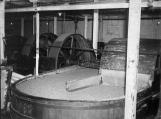27
An interview with a Power Generation department employeeThe board operator had the operation of all the power that came into the mill at that time and they distributed it from there, there was a distribution switch room behind the mezzanine floor wall. On the mezzanine floor where they had all these banks of switches, switch controls, they controlled all the generators throughout the mill, and the basic feeders feeding out of that.
There's one substation over at G3 - past the mill store, and that's where the power comes in from Lois River, and there's a high tension substation there, and there's transformer banks outside of that, and that delivered the power into the sawmill area, and 7-8 paper machines were fed out of that substation too.
There were three steam turbines on the system as well as the 1,2,3 & 4 generators powered out of Powell Lake. There were two [steam turbines] up in the steam plant, which fed on to the electrical bus up there, and there was one back pressure turbine down on number six paper machine. They were very small units, but they were used as reducing stations really, to break down high pressure steam to low pressure steam which they needed for the paper machines to dry out the paper. So they took a bit of power out of the steam before they put it into it, and that's why they were installed in those places.
The board operators had control of the generators when they were being synchronized - added to the power system. You take them off the line when you want to maintain them, and then you re-synchronize them. In this case, the water wheels, the wheel man would bring the water turbine up to speed, and it has to be right on, and then the board operator would synchronize it to the line. Everytime you bring a machine on it has to be synchronized.
Tape transcript
People of the White City
29
An interview with an electrician in the Power Generation DepartmentThere's one substation over at G3, and there's one operator on each shift up there looking after the grinder rooms. There were three lines of grinders at that time, (and three) big electric motors feeding the grinders. There were distribution switches up there as well that we looked after, and we changed fuses and things in the grinder room. That's the sub-operators' job. So they had the wheel man, the sub-operators, and the board operators. (Board operators became control room operators).
When they added the second machine out at Lois River, things got kind of top heavy on that end, and they were having a lot of shut downs with machines tripping out and overloaded and those kinds of things. So (an electrical engineering firm) came in and re-engineered the distribution system. That meant they put substations in the areas where the power was needed the most, and they ended up with 12 substations altogether, and it was a ring-loop system around the mill. At that time, they put another steam turbine up in number one steam plant, which was just taken out of there recently, and they built quite a nice control room up there above a few of the offices for the steam plant, and that's where the control room operator was stationed.
(There was one control room operator per shift) for the whole mill. You handled all the power for the whole mill from there - electrical power- the generation and the main feeder switches. They had loop breakers connecting each substation to the loop so they could feed around the loop if they had trouble in one spot, between two substations - they could feed the opposite way around and it meant that you had much more security for continued operation.
tape transcript
People of the White City
31
What type of man is this boom man, the man who first starts the potential roll of newsprint on its way to the publishing house? It is no job for the weakling, for the man slow of wit or slow of movement. The boom man must be strong and wiry, quick on his feet and possessed of a better than average sense of balance. He should be a man who has previously worked in the woods, for he must be able to detect at a glance the various types of logs in the pond. When the voice of the foreman shrills over the loud-speaker asking for more hemlock, the boom man must be able to send up hemlock without delay.Most boom men are strong swimmers. No matter how careful or agile he may be, there is no boom man alive who hasn't been pitched off a "bucking" log, sometimes into open, storm-tossed water. Immersions are not infrequent in this hazardous battle against rolling logs--and a knowledge of swimming is a must in this profession.
And above all, it is no game for the rugged individualist, who wears no man's collar and goes his own way regardless of others. Ability to get along with his fellow workman is all important. Working in groups of five and six, teamwork is the keynote in the boom man's daily tasks.
R. (Barney) MacDonald,
Powell River Digester
Vol 24, No. 4
July-August, 1948
32
Guiding LogsCirca 1926
Powell River, British Columbia, Canada
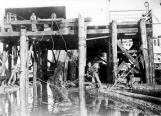 Credits:
Credits:P04644
Catalyst Paper, Powell River Division
Oren Olson
33
Until the recent advent of the aeroplane and direct road connection between Powell River and outside points, the district, as far as quick and easy transportation of supplies was concerned, remained comparatively isolated.There were naturally disadvantages under such conditions. But there were counterbalancing advantages. In particular, our plant mechanics, millwrights, and tradesmen, unable to obtain quick deliveries for emergency repairs or installations, were forced to rely on their own ingenuity, and to use their own equipment and staffs for material that would otherwise have been purchased from a machinery or equipment firm.
As a result, the plant at Powell River is, in many respects, self-reliant--and as one equipment salesman rather ruefully remarked--"a competitor of ours."
A typical example is the existence of a well equipped plant pattern shop in charge of a highly skilled craftsman. The patterns for new parts are fashioned by the patter maker, then cast into metal by the foundry, finished by machinists and installed in the mill by millwrights and other specialists.
A well-known write, Edward Leslie, has said of the pattern maker that he must possess "the creative conception of a draughtsman designer, the practical ability of a moulder, the precise skill of a machinist, the analytical judgement of a metallurgist and the specific exactness of a mathematician."
Over the years Powell River has been fortunate in having Old Country trained craftsmen who successfully measured up to Mr. Leslie's ideal.
Powell River Digester
Vol. 32, No. 6
November-December, 1956
34
The Pattern Shop2 November 1956
Powell River, British Columbia, Canada
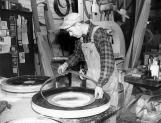 Credits:
Credits:PC-SD13
R.F. Metcalf, photographer
35
In the manufacture of newsprint few people realize the multiplicity of occupations necessary for the conversion of the hall hemlock and spruce trees of the Pacific Coast into that daily newspaper which is such a necessity in our daily lives. One of these occupations is that of the acid maker.Approximately 12 percent of every newspaper is sulphite pulp, produced chemically, by cooking to disintegration, hemlock chips in a solution of sulphurous acid and a compound known as calcium bisulphite. The acid maker is the man who is responsible for production of the sulphurous acid so necessary and vital to manufacture of newsprint.
For every ton of sulphite pulp made, 1200 gallons of water, 265 pounds of sulphur and 325 pounds of limestone are required to be combined, and it is the acid maker who does just that.
Sulphur, imported from the high grade areas of Texas, is the foundation on which the acid maker operates his jobs. The sulphur, reduced to a molten state, is then pumped into a giant rotary burner. Air is also introduced; and as the sulphur burns, the blue flame is driven out the rear end of the burner, additional air is introduced--and the mixture passes through three large combustion chambers to a large cooler, made of lead pipes, immersed in cold water.
The blue flame, which is the gas given off by the burning sulphur, is sulphur dioxide, essential in the chip reducing process. It is of vital importance that the strength of this gas be kept constant, as complications may upset the whole picture. The acid maker must be certain that it is not to strong or too weak. If it is too strong there will be incomplete combustion--and the cooler and gas lines will be clogged. Too weak a solution brings a different chemical reaction.
The acid maker must set the burner draft, control the gas strength, watch his recorders vigilantly and scrutinize carefully his testing apparatus. It is painstaking work--and a miscalculation or negligence can hold up production and waste hundreds of dollars.
Wilfred Heritage
Acid Maker
The Powell River Digester
Vol 24, No. 5
November-December 1948
36
Acid TowerCirca 1923
Powell River, British Columbia, Canada
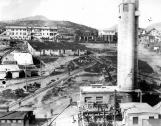 Credits:
Credits:P00516
Catalyst Paper, Powell River Division
37
In the production of sulphite pulp, on which such a large portion of the paper industry depends, sulphur is indispensable. Gleaming yellow mountains of sulphur are a common sight around a sulphite mill. It is usually fed in the molten state into a burner where it is burned with air to form sulphur dioxide. The hot gas is cooled in lead pipes immersed in water and the gas then passes on to the absorption towers where it begins the long journey it has to make before it, combined with other chemicals, becomes the "cooking liquor" with which sulphite pulp is produced.Men and Paper,
Vol. 3, No. 51
May 14, 1949
39
Beater EngineerAlthough describing a position at the Island Paper Mills on Annicis Island, New Westminster, B.C., this description would fit the equivalent position at the Powell River mill.
In Beater Engineer's world, black makes white and green makes pink, and it all adds up to production of a wide variety of high quality paper.
....a Beater Engineer at MB's Island Paper Mills on Annacis Island, New Westminster. He and his crew are the plant's "kick-off aquad"--they begin the whole process of turning bales of pulp into a wide variety of fine papers.....
The most important tool of his trade is his eyesight, trained to tell at a glance if a paper's colour and dinsity meet the required standards and, if not, to give him the clue to what shold be done about it.
"Once we had an electronic machine here, designed to scan paper samples and make assessment," "No doubt the theory behind it was sound, but after a while we went back to using eyes and experience."
Asked about special qualifications for his job as Beater Engineer, he replied: "You need patience and the ability to work as part of a close team. And it helps if you're not colour blind."
MacMillan Bloedel News
Vol. 8, No. 2
February 1971
